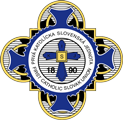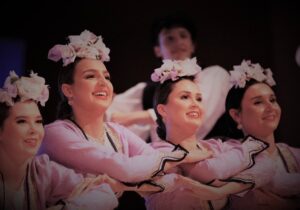It is no secret that immigrants have provided our nation with a strong and blessed support. Our Sisters who emigrated from central Europe have contributed mightily not only by their spiritual presence but also by the works they have performed in convents, parishes, schools, hospitals, homes for the elderly and by their very presence which has brought joy and comfort to all with whom they came into contact.
If my calculations are correct, fifty-one Sisters have come to the U. S. to live fruitful lives and to minister to people who always proved to be thankful for their presence.
The next sister in the series, Sister Mary Anna Pavelka, immigrated from Vieska, Slovakia to become our designated horticulturist.
- Sister Bernadette Marie Ondus, SSCM
Sister Mary Anna Pavelka
 One of the Sisters who came from Vieska, Slovakia, became what we designate as a horticulturist. Even as a young person Mary Anna was interested in plants, flowers, sunshine and soil. When she became an SSCM, it was clear what her ministry would be, tending the truck garden and fruit orchards at our Motherhouse, Villa Sacred Heart in Danville, PA. Later, she had a dedicated helper, Sister Isidore, who also had a background in agriculture since she had come from a farming family in Connecticut. Sandy McCloughan, who lives here in Danville, PA, later joined the two Sisters and contributed her willingness and expertise at Villa Sacred Heart. Sister Mary Anna, who was formerly known as Sister Afra, had a motto she always lived by, “Never think you are doing too much.” It is no surprise that Sister Isidore and Sandy also lived by that motto.
One of the Sisters who came from Vieska, Slovakia, became what we designate as a horticulturist. Even as a young person Mary Anna was interested in plants, flowers, sunshine and soil. When she became an SSCM, it was clear what her ministry would be, tending the truck garden and fruit orchards at our Motherhouse, Villa Sacred Heart in Danville, PA. Later, she had a dedicated helper, Sister Isidore, who also had a background in agriculture since she had come from a farming family in Connecticut. Sandy McCloughan, who lives here in Danville, PA, later joined the two Sisters and contributed her willingness and expertise at Villa Sacred Heart. Sister Mary Anna, who was formerly known as Sister Afra, had a motto she always lived by, “Never think you are doing too much.” It is no surprise that Sister Isidore and Sandy also lived by that motto.
Much of what follows are Sandy’s memories of Sister Mary Anna. When Mary Anna was still young, her dad died. Known to be able to work with incredible speed, Mary Anna helped her mother weed the garden. When her mother realized how fast she could work, she gave Mary Anna two rows to weed instead of one.
When she was about eight, Mary Anna and her mother attended the final profession of a second cousin, Sister Emerita. When Sister asked Mary Anna “What are you going to be when you grow up?” she quickly replied, “I’m going to be a Sister.” When Sister Emerita asked, “What are you going to do as a Sister?’ Mary Anna smiled and said, “I’m going to take care of flowers.”
When Mary Anna immigrated to the U. S. as a so-called “Greenhorn,” she lived with her aunt and uncle in Broome County in New York state. She did piece work in a shoe factory where her uncle also worked. Mary Anna, however, made more money than he did because, as she proved back home in Slovakia, she could work at phenomenal speed.
One of the products of her devotion to producing beauty in the form of flowers is a memory treasured by those who, like Sister Donna Marie, remember the time the Feast of Christ the King was celebrated at the end of October. The altar in the chapel (now the Basilica) at the Motherhouse was decorated with large gold chrysanthemums. Those who prayed there on that special day could not help but be in awe of her contribution to the beauty of the altar where the Blessed Sacrament was present for adoration.
It was not just chrysanthemums, however, that enhanced the beauty of our place of worship, but also orchids, calla lilies, gardenias, camellias and poinsettias. Of all the flowers Sister Mary Anna grew so lovingly, the calla lily was her favorite. The Christmas poinsettias which grew to six feet were saved from the year before and cultivated for the next year’s celebration. It might have been a problem to transport them to the chapel but, of course, not for Sister Mary Anna. She used her creativity to fashion sides and a top for her old jeep so they would be protected in transit. Not only was Christmas and Forty Hours special but the Easter season as well. Sister Mary Anna planted 250 Easter lily bulbs and a few weeks later 250 more. What an array of lilies adorned the altar at this special time of the Lord’s Resurrection.
Sister Nadine, OSF, considers Sister “a saint.” She remembers “how hard Sister worked in full habit under the grueling sun.” Sister Nadine also recognized that Sister Mary Anna had a special way with plants. She believes that Sister Mary Anna spoke to the plants and they did her bidding. As proof she offers this: “She always had the poinsettia plants blooming for Christmas and she always had them in the right series of heights to frame the altar in the Basilica.” Continues Sister, “I was really impressed when I saw her come in all dirty from the farm and somehow be all cleaned up for chapel and dinner.”
Sister also made corsages for the Academy girls, wreaths from the grapevines for Christmas and heart-shaped ones for Valentine’s Day as well as pussy willows, money plants, and dry flower arrangements for the yearly women’s retreats. Sister also made artificial flower arrangements which might include dried weeds picked from the field. These and live plants were sold at the annual Summer Festival.
 Besides working in the barn, the greenhouse, the vegetable and flower gardens, and tending the grapevines, the Sisters pruned and sprayed the fruit trees, cherry, pear, plum, peach, and of course apple, so that in the fall the Sisters could enjoy delicious apple cider. The apples were harvested on one day, and the next they were pressed, using our own cider press. According to Sandy, there was a time that the apples grown in our orchards were used by an applesauce company.
Besides working in the barn, the greenhouse, the vegetable and flower gardens, and tending the grapevines, the Sisters pruned and sprayed the fruit trees, cherry, pear, plum, peach, and of course apple, so that in the fall the Sisters could enjoy delicious apple cider. The apples were harvested on one day, and the next they were pressed, using our own cider press. According to Sandy, there was a time that the apples grown in our orchards were used by an applesauce company.
Sandy has another story that focuses on Sister Mary Anna and trees. Sister had a bad back which gave her considerable pain. One day Sister fell out of a tree, an apple tree no doubt. From that day on, miraculously, she no longer had back pain. Sandy does not recommend this “remedy” for back pain, however.
Naturally on such a productive operation one needed dogs. Over the years there were three barn dogs, Lad, Snowball and Lassie. In the far distant past, Sister Mary Anna also raised chickens. The eggs they produced, one or two at a time, were carried in a basket, by one of the dogs, either Lad or Snowball. Because the dog swayed as he carried the basket, the eggs would crack.
When she visited her home in 1967, Sister Mary Anna kept a record of events in a small black book written in Slovak. Someday it would be wise to translate it into English so that all may share in her love for family, especially her two sisters, Anne and Lenora, and for her native land.
A special joy was having a nephew a priest, Father Štefan Vargaš in Vienna, Austria, with whom she corresponded. Father wrote a touching note to Sister Paracleta when she informed him of Sister’s death. “She was deeply religious, sacrificing for God and her dear ones,” he said. He commended Sister Mary Anna for praying for Slovakia and the church in Slovakia “suffering under an oppressive political regime. Her prayers helped her country become free,” he said. Father expressed gratitude for her prayers for him and his priesthood.
When her health failed, Sister went to GMC for her ailing heart and on discharge told the doctor she was going home to heaven. When the Sisters who were caroling on Christmas night stopped at her room, she asked them to sing, “Narodil sa Kristus Pan,” her favorite carol. She sang softly with them. Sister Mary Anna died early on the morning of the feast of St. John the Evangelist. In his Gospel, St. John speaks of light and life. Of course we are aware of the importance of light to the growth of crops, but we must also consider how important light is to sight as we ponder what occurred at Mary Anna’s birth. To her dismay Mary Anna’s mother saw that her daughter had only flesh where her eyes should have been. She asked Mary Anna’s aunt to get water from a nearby shrine and faithfully poured water on the place her eyes should have been until they appeared. Since her mother always reminded Mary Anna that the Blessed Virgin Mary gave her sight, it is no surprise that Sister had great devotion to Mary and her Rosary.
Sister Mary Anna summed up her work in these words, “The flowers are God’s handiwork, and we are here to see they get special treatment. We do God’s work all year round and we love it.” Surely she was speaking for those who worked with her also, especially Sister Isidore and Sandy.
Currently in the archives are photos and articles from local newspapers of Sister Mary Anna. Because of their fascination with Sister’s work, they asked to interview her. For example, Sister is pictured on a tractor in the September 7, 1984 issue of the Shamokin News-Item and in the Danville News on September 10, 1994. Even her obituary carries a photo of Sister standing by her truck.
Sister Mary Anna completed 66 years in the Lord’s service. As already mentioned, she died on the feast of St. John the Evangelist, December 27, 1994, and was buried on December 29. The celebrant and homilist of the liturgy was Father Edward Deller, Maria Hall chaplain, and concelebrants, Father Augustine Zan and Father V. Leonard Casey. In her tribute, Sister Paracleta called Sister Mary Anna “a symbol of life and growth.” “Rejoice,” she said “because she died within the octave of Christ’s new birth among us and several days after the winter solstice when days begin to lengthen and move slowly toward a new spring and creation’s rebirth.” Those of us who live at Villa Sacred Heart can never forgot what Sister Mary Anna accomplished as we look out at the grounds, the fruit trees, the grapevines and recall her steadfast dedication to tending and preserving the beauty of the earth.



